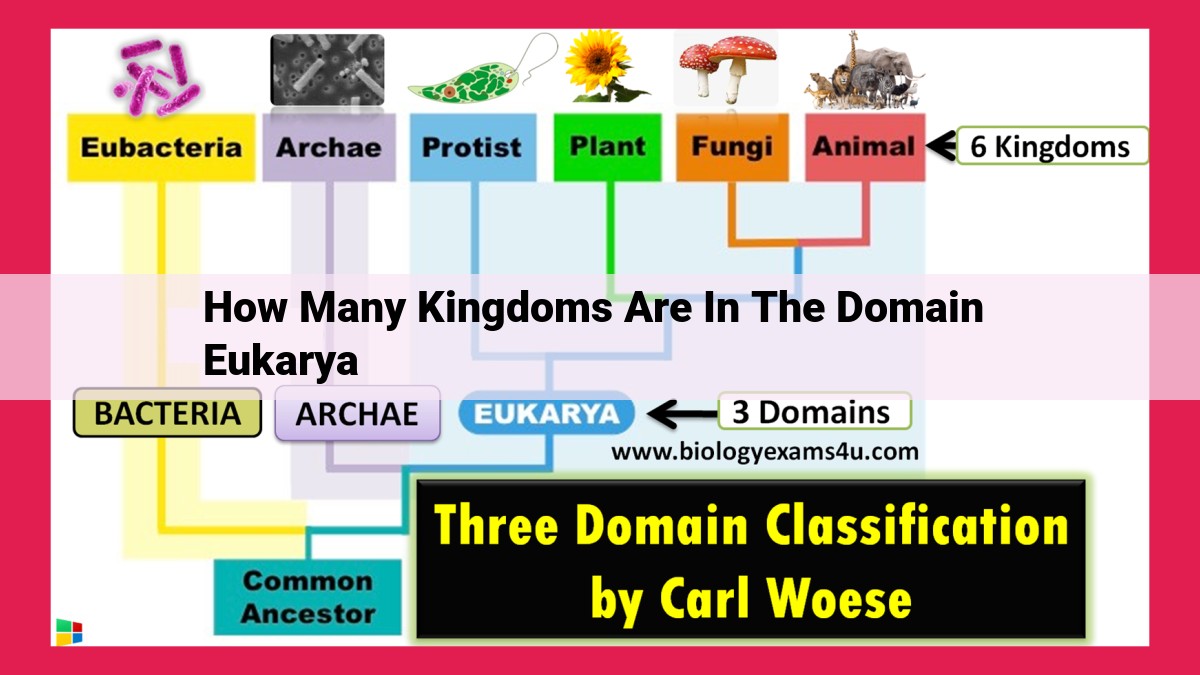Unveiling The Five Kingdoms Of Eukarya: A Comprehensive Guide To The Eukaryotic Domain

The domain Eukarya encompasses organisms with eukaryotic cells, characterized by the presence of a nucleus and other membrane-bound organelles. Within Eukarya, there are five kingdoms: Protista, Plantae, Fungi, Animalia, and Chromista. Protista comprises eukaryotic organisms that do not fit into other kingdoms, such as algae and protozoa. Plantae consists of photosynthetic eukaryotes with cell walls made of cellulose. Fungi are heterotrophic eukaryotes that absorb nutrients from their surroundings. Animalia includes multicellular eukaryotes that ingest food and possess specialized tissues and organs. Chromista, added later, encompasses algae with chlorophyll c as well as other eukaryotic organisms. Thus, there are five kingdoms within the domain Eukarya.
Delving into the Realm of Eukarya: A Domain of Diversity and Complexity
In the vast and ever-expanding tapestry of life on Earth, scientists have classified organisms into three primary domains: Bacteria, Archaea, and Eukarya. Eukarya stands out as a domain of profound complexity and diversity, hosting an astonishing array of life forms that share a common set of defining traits.
To embark on our exploration of Eukarya, let us first delve into the concept of a “domain” within the field of taxonomy. A domain represents the highest rank in the hierarchical classification system used to organize living organisms. It encompasses all life forms that share a fundamental set of characteristics that set them apart from other domains.
The domain Eukarya encompasses organisms that are eukaryotic, meaning they possess cells with a true nucleus enclosed within a nuclear membrane. This defining characteristic distinguishes eukaryotes from prokaryotes, which lack a membrane-bound nucleus and other intricate cellular structures. The presence of a nucleus in eukaryotic cells allows for the segregation of genetic material, enabling the compartmentalization of cellular functions and facilitating the development of more complex organisms.
The Diverse Kingdoms of Eukarya
In the vast tapestry of life on Earth, the domain Eukarya stands out as a realm of complex and fascinating organisms. Eukaryotic cells, the hallmark of this domain, possess a distinct nucleus, membrane-bound organelles, and a sophisticated genetic machinery. Within Eukarya, we find a diverse array of life forms classified into four major kingdoms: Protista, Plantae, Fungi, and Animalia.
Kingdom Protista: A Realm of Diverse Eukaryotes
Protista encompasses a vast array of unicellular and multicellular eukaryotes that defy easy categorization. These organisms inhabit a wide range of environments, from the depths of the oceans to the moist soils of forests. Protists exhibit remarkable diversity in their forms and functions, including algae, protozoa, and slime molds.
Kingdom Plantae: Masters of Photosynthesis
The kingdom Plantae comprises multicellular eukaryotes that are distinguished by their ability to photosynthesize. These sessile organisms, rooted in the ground or aquatic environments, harness the energy of sunlight to convert carbon dioxide and water into glucose and oxygen. Plants play a crucial role in the global carbon cycle and provide the foundation of most terrestrial food chains.
Kingdom Fungi: Decomposers and Symbionts
Fungi are multicellular eukaryotes that lack the ability to photosynthesize. Instead, they obtain nutrients by decomposing organic matter. These diverse organisms include mushrooms, yeasts, and molds, which inhabit a variety of ecosystems. Fungi play a vital role in nutrient cycling and contribute to the breakdown of dead organisms. They also form symbiotic relationships with other organisms, such as mycorrhizae, which enhance plant growth.
Kingdom Animalia: The Animal Kingdom
Animalia constitutes a vast and diverse kingdom of multicellular eukaryotes that are characterized by their ability to move. Animals possess specialized sensory organs, nervous systems, and muscular structures that allow them to navigate their environments and interact with other organisms. They exhibit a wide range of dietary habits, from herbivores and carnivores to omnivores and parasites.
The Kingdoms of Eukarya: Classifying the Diverse World of Life
Embarking on a scientific voyage, we encounter the fascinating realm of Eukarya, a domain of life that unites organisms with intricate cellular structures, including the familiar kingdoms of Protista, Plantae, Fungi, and Animalia. But did you know that the taxonomic hierarchy of Eukarya extends beyond these four well-known groups? Let’s delve deeper into the concept of “kingdom” within the classification system and uncover the true number of kingdoms within the Eukarya domain.
What is a Kingdom?
In the biological classification system, a kingdom represents a taxonomic rank, a broad category that groups together organisms sharing fundamental characteristics. Kingdoms are further subdivided into smaller groups, such as phyla, classes, and orders, creating a hierarchical structure that reflects evolutionary relationships.
The Five Kingdoms of Eukarya
Historically, biologists recognized four kingdoms within Eukarya: Protista, Plantae, Fungi, and Animalia. However, advancements in phylogenetic analyses and molecular biology have led to a more nuanced understanding of eukaryotes and the identification of an additional kingdom: Chromista.
- Chromista: This kingdom encompasses organisms such as algae, diatoms, and water molds. They possess unique photosynthetic pigments and are essential contributors to aquatic ecosystems.
The Significance of Kingdoms
Kingdoms play a vital role in organizing and classifying the vast diversity of life on Earth. They represent major evolutionary lineages, highlighting the remarkable adaptations and variations that have occurred over billions of years. Kingdoms are not merely arbitrary divisions but reflect fundamental biological differences and shared ancestry.
The concept of “kingdom” in the Eukarya domain is a testament to the intricate complexity and hierarchical nature of the classification system. By understanding the five kingdoms of Eukarya – Protista, Plantae, Fungi, Animalia, and Chromista – we gain a deeper appreciation for the diversity of life and the evolutionary forces that have shaped our planet.